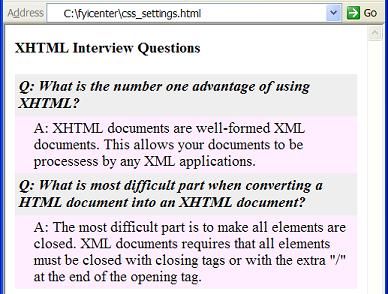Using HTML 'div' Elements with CSS Properties
How To Use "div" Elements to Change CSS Properties?
✍: FYIcenter.com
![]() As elements containers, "div" elements are perfect places to set CSS properties
which will be applied to all elements in the container. Here is a tutorial
example of how to set CSS properties on "div" elements:
As elements containers, "div" elements are perfect places to set CSS properties
which will be applied to all elements in the container. Here is a tutorial
example of how to set CSS properties on "div" elements:
<?xml version="1.0" ?> <!DOCTYPE html PUBLIC "-//W3C//DTD XHTML 1.0 Strict//EN" "http://www.w3.org/TR/xhtml1/DTD/xhtml1-strict.dtd"> <html> <head> <title>DIV Elements with CSS Properties</title> </head> <body> <div> <h4>XHTML Interview Questions</h4> <div style="background-color: #eeeeee; padding: 4px; font-style: italic; font-weight: bold"> Q: What is the number one advantage of using XHTML? </div> <div style="background-color: #ffeeff; padding: 4px 4px 4px 20px;"> A: XHTML documents are well-formed XML documents. This allows your documents to be processed by any XML applications.</div> <div style="background-color: #eeeeee; padding: 4px; font-style: italic; font-weight: bold"> Q: What is most difficult part when converting a HTML document into an XHTML document?</div> <div style="background-color: #ffeeff; padding: 4px 4px 4px 20px;"> A: The most difficult part is to make all elements are closed. XML documents requires that all elements must be closed with closing tags or with the extra "/" at the end of the opening tag.</div> </body> </html>
If you save the above document as css_settings.html and view it with Internet Explorer, you will see that CSS properties are specified for different "div" elements as shown below:

2017-03-11, 1518🔥, 0💬